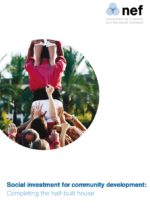Social investment for community development
Five steps to complete the infrastructure for a thriving social investment market in the UK
23 September 2008
Community finance has had a significant impact on some of the most disadvantaged communities, leveraging in millions of pounds of investment.
The community finance sector – including credit unions, community development finance institutions (CDFIs), social enterprise finance funds, and community development venture capital funds (CDVC) – has a key role to play to revitalise local communities in partnership with other entities, such as financial institutions, housing associations, development trust associations, local authorities and Regional Development Agencies (RDAs).
Community finance organisations are key components of the network of institutions that, if designed well and with supportive policies, can work together to form an effective social investment market. Increasingly private finance is seeking opportunities to invest in enterprises or projects with social objectives to redress economic exclusion and poverty or support community regeneration.
This social investment marketplace has potential to channel substantial funds to social and community enterprises. It requires a supportive policy environment that recognises the value of long-term funding for third sector organisations and puts in place the requisite tax and legislative mechanisms to build and sustain social investment institutions. Currently this architecture is half-built.
The recommendations of the Social Investment Task Force (SITF) in 2000 were successful to put in place the basic foundations for a social investment marketplace. SITF brought about a gradual shift in thinking and awareness of the role of private finance to achieve social outcomes and positive change for underinvested communities. But while some of the initial SITF recommendations have been fully adopted, there is still a long way to go.
Following the original SITF recommendations, we have identified five clear steps required to complete the infrastructure for a thriving social investment market in the UK.
- Implement a simple and well-designed tax mechanism to attract private investors, including financial institutions, to social enterprises, including community development finance organisations.
- Legislate compulsory disclosure by financial institutions of lending and investment in disadvantaged areas, as a means of tracking performance and stimulating the flow of finance to communities in need of redevelopment.
- Establish a grant fund for long-term public support of third sector finance institutions to maximise their ability to leverage private finance, improve lending practices and enhance technical capability. Many third sector institutions will require ongoing grant funding to carry out the activities that have the most social benefit.
- Design a matched funding scheme to incentivise charitable foundations to invest in social enterprises and encourage use of endowments for social investment purposes.
- Support development of a new social finance institution that can act as a wholesale organisation to co-ordinate and channel investment to existing third sector intermediaries, to link the social and financial sectors.
This report finds that the architecture for a social investment market that will channel finance to community development is incomplete.
- Too few community finance organisations have been able to attract sufficient private investment to reach a scale that allows them to fulfil their potential for disadvantaged communities.
- Public funding for the community finance sector has been short-term, patchy and increasingly scarce.
- Community investment tax relief (CITR) is widely viewed as too complex and narrow to attract sufficient investment capital, and is in need of revision.
- Incentives for charitable trusts and foundations to invest their substantial endowments in community finance and other social enterprises have not been forthcoming.
- Banks have largely avoided transparency and disclosure of their lending and investment in disadvantaged communities.
- A voluntary agreement with banks to invest in disadvantaged neighbourhoods has resulted in a mediocre response. Bank partnerships with community finance organisations are the exception rather than the rule.
- Political support appears to be waning to capitalise a social investment bank to act as a wholesale institution providing much-needed capital to the sector.
- Much more could be done at a policy level to support social enterprises and community finance organisations that are vital outposts in some of the most disadvantaged communities.
- A new form of funding for the third sector is required. Third sector institutions require a long-term, dedicated source of investment capital that is tailored to the needs of each organisation.
The main aim of this report is to encourage policy-makers to address shortcomings in policies to support social investment for community development. Appropriate and enabling legislation, financial and tax mechanisms are required to support a thriving community finance sector. It is disgraceful to abandon a half-built house.
Further steps are required to build a strong community finance sector that is part of a thriving social investment marketplace, where private financial flows can be channelled to well-managed social and community enterprises that create real and lasting change for disadvantaged neighbourhoods.
We address three key issues facing community finance and the social investment marketplace:
- The need for continuing support to the community finance sector in the form of policy reform and continuous, appropriate funding.
- The appropriate role of banks and the wider financial sector to combat financial exclusion and invest in disadvantaged communities. This includes banks’ obligation to lending disclosure and the potential for legislation to enable a more active role for banks.
- The future form of a wholesale institution for social finance, such as the proposed Social Investment Bank, which would be capitalised by unclaimed assets held by financial institutions.
Topics Local economies







